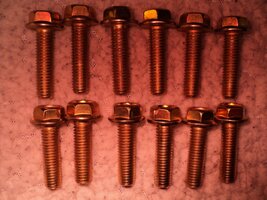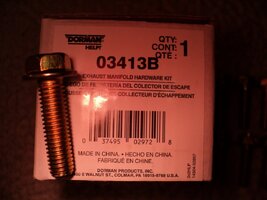Forgive me ... but you seem to keep plowing the same field, over and over... with some expectation that the the "seeds of the solution" will germinate into "easier plants" for you to harvest. If you have found "loose bolts" on the Exhaust Manifold Flange... you will have to act one way or another....if for no other reason than for the sake of guiding noxious exhaust down, into...and after proper chemical conversion therein...out of the exhaust pipe...and NOT dumping carbon monoxide in life-threatening amounts... inside the engine nacelle.
If you only change the exhaust manifold instead of an R&R of the catalytic converter... then all of these suggestions and recommendations will amount to nothing. You have a good chance of eliminating all four problems presented here at the same time... albeit with a need for a bit more planning and research on your part on how to do the work and naturally... with more expense for what should become a very long term fix:
(1) Possible Cracked or Warped Exhaust Manifold. (Examine the Old One? TOSS IT!)
(2) Clogged Catalytic Converter. (Get some $$$ Back @ The Junk Yard)
(3) Loose or Broken Exhaust Manifold Bolts. (TOSS THE OLD ONES)
(4) Ultimately... Solving the problem of "Thermal Runaway" for GOOD.
Any articles written that advocate using thread-locker should be looked upon with a jaundiced eye. If the bolts being used last happen to be made of Stainless Steel... they will eventually interact with the Aluminum Metal Head electrolytically... and form heavy electrolytic corrosion that offers no structural strength and either become looser...or seize in place...but not necessarily in concert with the bottom of the bolt face remaining in hard contact with the outer flange surfaces of each bolt hole in the exhaust manifold... in other words... be seized in the head...but NOT holding the manifold to the head correctly. The Dorman Bolts are the way to go... and ...DO NOT RE-USE THE MLS (Multi-Layered-Steel GASKET OR FASTENERS... Toss them!
If anyone made the mistake of using High Temp Thread Locker on the EM Bolts ... Don't automatically assume that they will not come out! Don't do ANYTHING extreme to remove them...and that include that you must abandon any idea of using or inducing "Heat" against the Exhaust Manifold and Bolts by means of any Propane, MAPP Gas or Ox-Acetelyne Torches... unless of course you want to compound your present problems... and burn your vehicle to the ground! What you need in this situation is NOT HEAT... but....FREEZING COLD to do the trick. That...and some good tools to allow you to work the bolts back and forth slowly and in micro-increments AFTER following the instructions listed next...
Again...If someone made the mistake of using any Thread Locker on the Exhaust Manifold Bolts... then your best ally in removing not only the Exhaust Manifold Bolts (on an Ice Cold Engine!) but for the Flange Bolts holding the upstream Catalytic Converter Three Bolt to Stud interface with the Exhaust Manifold as well...by obtaining a large can of
CRC "FREEZE-OFF" to thermodynamically "shock" the fasteners loose by freezing them and breaking the rust loose. Save your money trying WD-40, PB-Blaster, Kroil or Liquid Wrench and ....Just follow the instructions shown in these videos:
And YES... Using a small amount of Anti-Seize Compound on the New Bolts is EXACTLY what is called for... NOT THREAD LOCKER !!! Just Don't Over Torque Steel Bolts into the Soft Aluminum Threaded Holes! Take your time and think and work carefully as you do all of this.



